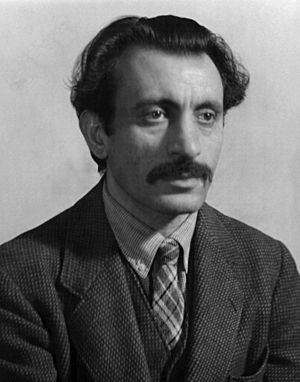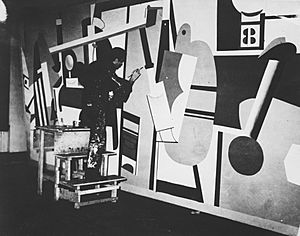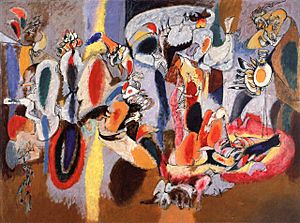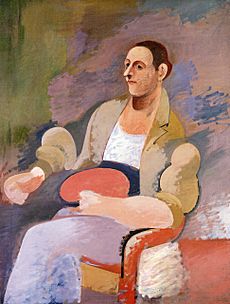Arshile Gorky facts for kids
Quick facts for kids
Arshile Gorky
|
|
|---|---|

Arshile Gorky in December 1936
|
|
| Born |
Vostanik Manoug Adoian
April 15, 1904 Khorgom, Vilayet of Van, Ottoman Empire, (formerly Armenia)
|
| Died | July 21, 1948 (aged 44) |
| Nationality | Armenian-American |
| Known for | Painting, Drawing |
|
Notable work
|
Landscape in the Manner of Cézanne (1927) Nighttime, Enigma, Nostalgia (1930–1934) |
| Movement | Abstract Expressionism |
Arshile Gorky (born Vostanik Manoug Adoian; April 15, 1904 – July 21, 1948) was an Armenian-American painter. He was a very important artist for a style called Abstract Expressionism. Many people consider Gorky to be one of the most powerful American painters of the 20th century. This includes famous artists like Mark Rothko, Jackson Pollock, and Willem de Kooning. The difficult experiences Gorky faced, especially during the Armenian genocide, deeply influenced his art.
Contents
Early Life and New Beginnings

Arshile Gorky was born in a village called Khorgom, near Lake Van in what was then the Ottoman Empire (now Turkey). He was born on April 15, 1904, though he sometimes changed his birth year later in life. In 1908, his father moved to America to avoid being forced into the army. He left his family behind in the town of Van.
In 1915, Gorky, his mother, and his three sisters had to leave their home because of the Armenian genocide. They escaped to an area controlled by Russia. Sadly, Gorky's mother passed away from hunger in Yerevan in 1919. In 1920, when he was 16, Gorky arrived in America. He was reunited with his father, but they never became very close.
To start a new life, he changed his name to "Arshile Gorky." He even told people he was a noble from Georgia and related to the famous Russian writer Maxim Gorky.
His Journey as an Artist
In 1923, Gorky started studying at the New England School of Art in Boston. He later became a part-time teacher there. In the early 1920s, his art was influenced by Impressionism. Later, he moved towards Post-Impressionism. He lived in New York City and was inspired by the artist Paul Cézanne. From 1925 to 1931, he taught at the Grand Central School of Art.
In 1927, Gorky became good friends with Ethel Schwabacher, who later wrote his first biography. Gorky believed that an artist's thoughts and dreams were the most important parts of their work. He said he used art to share his deepest feelings and how he saw the world.
In 1933, Arshile Gorky was one of the first artists to work for the Works Progress Administration Federal Art Project. This government program helped many artists during the Great Depression. Other famous artists like Jackson Pollock and Mark Rothko also worked on this project.
In 1935, Gorky had his first solo art show in New York. It was called Abstract Drawings by Arshile Gorky.
Developing His Unique Style
Some of his important paintings from this time include Landscape in the Manner of Cézanne (1927) and Landscape, Staten Island (1927–1928). In the late 1920s and 1930s, he explored cubism, a style that uses geometric shapes. He then moved towards surrealism, which uses dream-like images.
His painting The Artist and His Mother (around 1926–1936) is a very famous and emotional portrait. It is based on a childhood photo of him and his mother in Van. Gorky made two versions of this painting. One is at the Whitney Museum of American Art, and the other is at the National Gallery of Art in Washington, D.C.. This painting is admired for its simple lines and smooth look.
The series of paintings called Nighttime, Enigma, Nostalgia (1930–1934) shows how complex his art was during this period. The painting Portrait of Master Bill is thought to be of a Swedish carpenter who Gorky traded art lessons with for work.

In the 1940s, Gorky showed his new work to André Breton, a leader of the Surrealist art movement. Breton was very impressed, especially by a painting called The Liver Is the Cock's Comb. He called it "one of the most important paintings made in America" and said Gorky was a true Surrealist. This was a huge compliment from Breton.
By 1944, Gorky had developed his own unique style, moving beyond the influences of Cézanne and Pablo Picasso. This period is considered the peak of his work. His painting The Liver Is the Cock's Comb is over six feet tall and eight feet wide. It shows an abstract landscape with soft, watery colors and sharp, thorn-like shapes.
Personal Life and Challenges
Gorky had a close relationship with artist Corinne Michelle West, who was his inspiration.
In 1941, Gorky married Agnes Ethel Magruder. He lovingly nicknamed her "Mougouch." They had two daughters, Maro and Yalda (who was later renamed Natasha). Maro Gorky also became a painter.
Starting in 1946, Gorky faced many difficult challenges. His art studio and many of his paintings were destroyed in a fire. He also had serious health challenges. In 1948, he was in a car accident that injured his neck and temporarily paralyzed his painting arm. Around the same time, his marriage ended.
On July 21, 1948, Arshile Gorky passed away. He is buried in North Cemetery in Sherman, Connecticut.
His Lasting Impact

Gorky's contributions to art in America and around the world were huge. His style, sometimes called "lyrical abstraction," created a "new language" in art. He helped guide two generations of American artists. His spontaneous and expressive paintings, like The Liver is the Cock's Comb (1944) and The Betrothal II (1947), directly led to the Abstract Expressionism movement. Many artists from the New York School said Gorky had a big influence on them.
Gorky was known for his excellent drawing skills. He used twisted but elegant lines to create "biomorphic" (life-like) shapes in his abstract paintings. He also layered colors to make complex scenes of lines and colors on the canvas.
His artworks combine elements of Surrealism and the rich colors of the School of Paris with his own unique artistic style. His paintings and drawings are displayed in major museums across America, including the National Gallery of Art, the Museum of Modern Art, and the Whitney Museum of American Art in New York. They are also in many museums worldwide, like the Tate in London.
Sadly, fifteen of Gorky's paintings and drawings were destroyed in a plane crash in 1962.
In 2005, Gorky's family created the Arshile Gorky Foundation. This group helps people learn more about Gorky's life and art. They are also working on a complete list of all his artworks.
In 2009, the Philadelphia Museum of Art held a major exhibition called Arshile Gorky: A Retrospective. This show later traveled to the Museum of Contemporary Art (MOCA) in Los Angeles in 2010. In 2021, during maintenance of one of his paintings, a hidden painting was discovered underneath! Both paintings were then shown together.
In 2015, a monument to Gorky was built in Edremit, a town near where he was born.
Art Market
Since 2016, Gorky's art estate has been represented by Hauser & Wirth, a well-known art gallery.
See Also
 In Spanish: Arshile Gorky para niños
In Spanish: Arshile Gorky para niños


